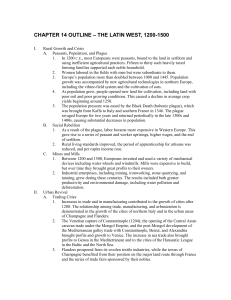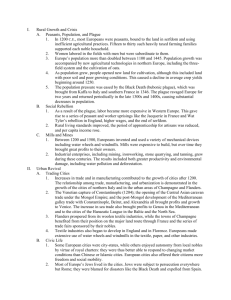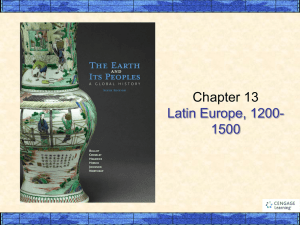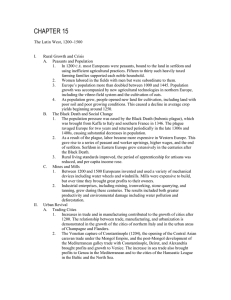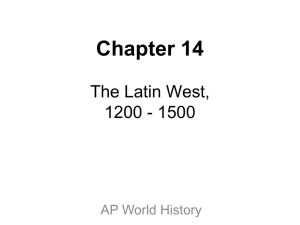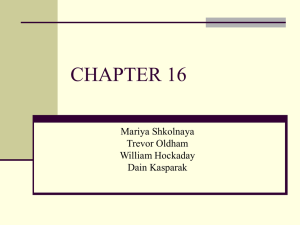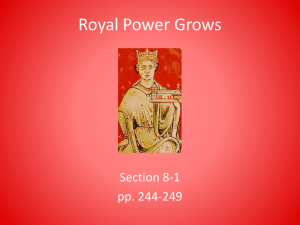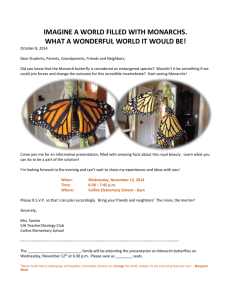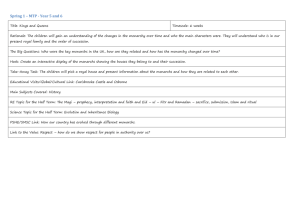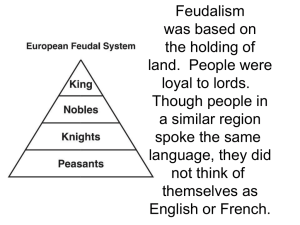Chapter 13 Outline
advertisement
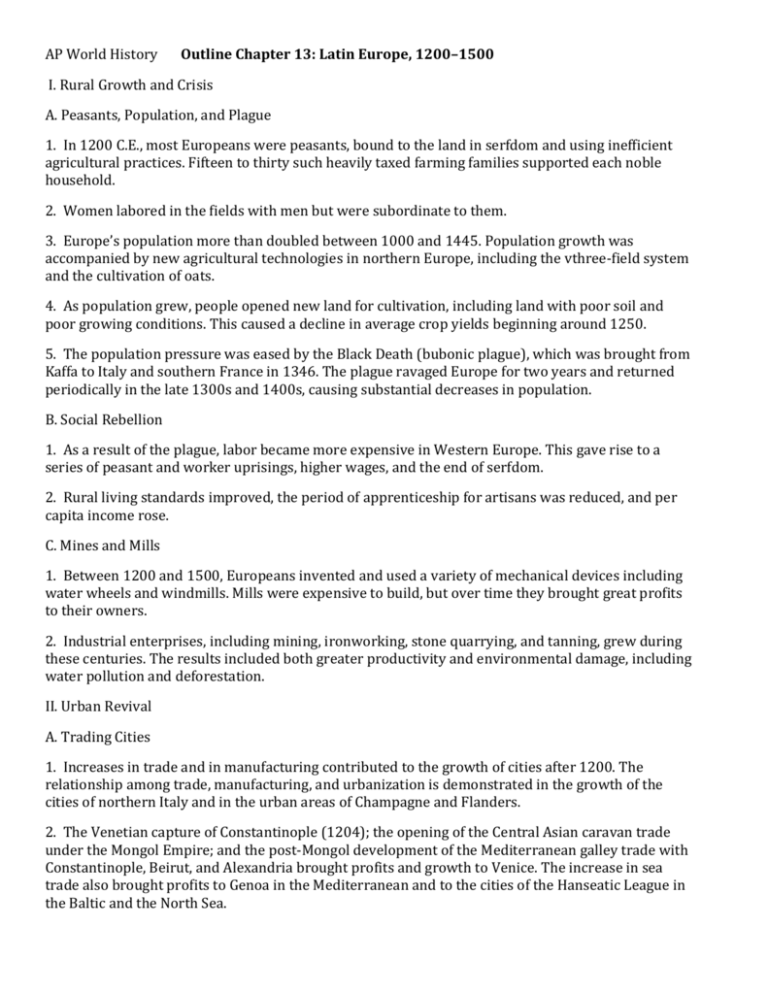
AP World History Outline Chapter 13: Latin Europe, 1200–1500 I. Rural Growth and Crisis A. Peasants, Population, and Plague 1. In 1200 C.E., most Europeans were peasants, bound to the land in serfdom and using inefficient agricultural practices. Fifteen to thirty such heavily taxed farming families supported each noble household. 2. Women labored in the fields with men but were subordinate to them. 3. Europe’s population more than doubled between 1000 and 1445. Population growth was accompanied by new agricultural technologies in northern Europe, including the vthree-field system and the cultivation of oats. 4. As population grew, people opened new land for cultivation, including land with poor soil and poor growing conditions. This caused a decline in average crop yields beginning around 1250. 5. The population pressure was eased by the Black Death (bubonic plague), which was brought from Kaffa to Italy and southern France in 1346. The plague ravaged Europe for two years and returned periodically in the late 1300s and 1400s, causing substantial decreases in population. B. Social Rebellion 1. As a result of the plague, labor became more expensive in Western Europe. This gave rise to a series of peasant and worker uprisings, higher wages, and the end of serfdom. 2. Rural living standards improved, the period of apprenticeship for artisans was reduced, and per capita income rose. C. Mines and Mills 1. Between 1200 and 1500, Europeans invented and used a variety of mechanical devices including water wheels and windmills. Mills were expensive to build, but over time they brought great profits to their owners. 2. Industrial enterprises, including mining, ironworking, stone quarrying, and tanning, grew during these centuries. The results included both greater productivity and environmental damage, including water pollution and deforestation. II. Urban Revival A. Trading Cities 1. Increases in trade and in manufacturing contributed to the growth of cities after 1200. The relationship among trade, manufacturing, and urbanization is demonstrated in the growth of the cities of northern Italy and in the urban areas of Champagne and Flanders. 2. The Venetian capture of Constantinople (1204); the opening of the Central Asian caravan trade under the Mongol Empire; and the post-Mongol development of the Mediterranean galley trade with Constantinople, Beirut, and Alexandria brought profits and growth to Venice. The increase in sea trade also brought profits to Genoa in the Mediterranean and to the cities of the Hanseatic League in the Baltic and the North Sea. AP World History Outline Chapter 13: Latin Europe, 1200–1500 3. Flanders prospered from its woolen textile industries, while the towns of Champagne benefited from their position on the major land route through France and the series of trade fairs sponsored by their nobles. 4. Textile industries also began to develop in England and in Florence. Europeans made extensive use of water wheels and windmills in the textile, paper, and other industries. B. Civic Life 1. Some European cities were city-states, while others enjoyed autonomy from local nobles: they were thus better able to respond to changing market conditions than Chinese or Islamic cities. European cities also offered their citizens more freedom and social mobility. 2. Most of Europe’s Jews lived in the cities. Jews were subject to persecution everywhere but Rome; they were blamed for disasters like the Black Death and expelled from Spain. 3. Guilds regulated the practice of and access to trades. Women were rarely allowed to join guilds, but they did work in unskilled non-guild jobs in the textile industry and in the food and beverage trades. 4. The growth in commerce gave rise to bankers like the Medicis of Florence and the Fuggers of Augsburg, who handled financial transactions for merchants, the church, and the kings and princes of Europe. Because the Church prohibited usury, many moneylenders were Jews; Christian bankers got around the prohibition through such devices as asking for gifts in lieu of interest. C. Gothic Cathedrals 1. Gothic cathedrals are the masterpieces of late medieval architecture and craftsmanship. Their distinctive features include the pointed Gothic arch, flying buttresses, high towers and spires, and large interiors lit by huge windows. 2. The men who designed and built the Gothic cathedrals had no formal training in design and engineering; they learned through their mistakes. III. Learning, Literature, and the Renaissance A. Universities and Scholarship 1. After 1100, Western Europeans got access to Greek and Arabic works on science, philosophy, and medicine. These manuscripts were translated and explicated by Jewish scholars and studied at Christian monasteries, which remained the primary centers of learning. 2. After 1200, colleges and universities emerged as new centers of learning. Some were established by students; most were teaching guilds established by professors to oversee the training, control the membership, and fight for the interests of the profession. 3. Universities generally specialized in a particular branch of learning; Bologna was famous for its law faculty, others for medicine or theology. Theology was the most prominent discipline of the period because theologians sought to synthesize the rational philosophy of the Greeks with the Christian faith of the Latin West in an intellectual movement known as scholasticism. B. Humanists and Printers AP World History Outline Chapter 13: Latin Europe, 1200–1500 1. Dante Alighieri (1265–1321) and Geoffrey Chaucer (1340–1400) were among the great writers of the later Middle Ages. Dante’s Divine Comedy tells the story of the author’s journey through the nine layers of Hell and his entry into Paradise, while Chaucer’s Canterbury Tales is a rich portrayal of the lives of everyday people in late medieval England. 2. Dante influenced the intellectual movement of the humanists—men such as Petrarch and Boccaccio, who were interested in the humanities and in the classical literature of Greece and Rome. The humanists had a tremendous influence on the reform of secondary education. 3. Some of the humanists wrote in the vernacular. Most of them wrote in Latin; many worked to restore the original texts of Latin and Greek authors and of the Bible through exhaustive comparative analysis of the many various versions that had been produced over the centuries. As a part of this enterprise, Pope Nicholas V established the Vatican Library, and the Dutch humanist Erasmus produced a critical edition of the New Testament. 4. The influence of the humanist writers was increased by the development of the printing press. Johann Gutenberg perfected the art of printing in 1454; Gutenberg’s press and more than two hundred others had produced at least 10 million printed works by 1500. C. Renaissance Artists 1. Fourteenth- and fifteenth-century artists built on the more natural paintings of Giotto as they developed a style of painting that concentrated on the depiction of Greek and Roman gods and of scenes from daily life. The realistic style was also influenced by Jan van Eyck’s development of oil paints. Leonardo da Vinci and Michelangelo were two of the famous artists of this period. 2. Wealthy merchant and clerical patrons like the Medicis of Florence and the church contributed to the development of Renaissance art. The artistic and intellectual developments of the Renaissance did not stop in Europe; the university, printing, and oil painting were later adopted all over the world. IV. Political and Military Transformations A. Monarchs, Nobles, and the Church 1. Thirteenth-century European states were ruled by weak monarchs whose power was limited by their modest treasuries, the regional nobility, the independent towns, and the church. 2. Two changes in weaponry began to undermine the utility—and therefore the economic position— of the noble knights. These two innovations were the armor-piercing crossbow and the development of firearms. 3. King Philip the Fair of France reduced the power of the church when he arrested the pope and had a new (French) one installed at Avignon, but monarchs still faced resistance, particularly from their stronger vassals. In England, the Norman conquest of 1066 had consolidated and centralized royal power, but the kings continued to find their power limited by the pope and by the English nobles, who forced the king to recognize their hereditary rights as defined in the Magna Carta. B. The Hundred Years War 1. The Hundred Years War pitted France against England, whose King Edward III claimed the French throne in 1337. The war was fought with the new military technology: crossbows; longbows; pikes (for pulling knights off their horses); and firearms, including an improved cannon. AP World History Outline Chapter 13: Latin Europe, 1200–1500 2. The French, whose superior cannon destroyed the castles of the English and their allies, finally defeated the English. The war left the French monarchy in a stronger position than before. C. New Monarchies in France and England 1. The new monarchies that emerged after the Hundred Years War had stronger central governments, more stable national boundaries, and stronger representative institutions. Both the English and the French monarchs consolidated their control over their nobles. 2. The advent of new military technology—cannon and hand-held firearms—meant that the castle and the knight were outdated. The new monarchs depended on professional standing armies of bowmen, pikemen, musketeers, and artillery units. 3. The new monarchs had to find new sources of revenue to pay for these standing armies. To raise money, the new monarchs taxed land, merchants, and the church. 4. By the end of the fifteenth century, there had been a shift in power away from the nobility and the church and toward the monarchs. This process was not complete, however, and monarchs were still hemmed in by the nobles, the church, and by new parliamentary institutions: the Parliament in England and the Estates General in France. D. Iberian Unification 1. Spain and Portugal emerged as strong centralized states through a process of marriage alliances, mergers, warfare, and the reconquest of the Iberian Peninsula from the Muslims. Reconquest offered the nobility large landed estates upon which they could grow rich without having to work. 2. The reconquest took place over a period of several centuries, but it picked up after the Christians put the Muslims on the defensive with a victory in 1212. 3 Portugal became completely established in 1249. In 1415, the Portuguese captured the Moroccan port of Ceuta, which gave them access to the Saharan trade. 4. On the Iberian Peninsula, Castile and Aragon were united in 1469 and the Muslims were driven out of their last Iberian stronghold (Granada) in 1492. Spain then expelled all Jews and Muslims from its territory; Portugal also expelled its Jewish population. V. Conclusion A. Ecologically, the peoples of Latin Europe harnessed the power of wind and water and mined and refined their mineral wealth at the cost of pollution and deforestation. A demographic crisis climaxed with the Black Death in the mid-fourteenth century. B. Politically, frequent wars caused kingdoms of moderate size to develop exceptional military strength. C. Culturally, autonomous universities and printing supported the advance of knowledge while new inventions underlay the new dynamism in commerce, warfare, industry, and navigation. D. Many of the tools that the Latin West used to challenge Eastern supremacy originated in the East. From the eleventh century onward, population pressure, religious zeal, economic enterprise, and intellectual curiosity drove expansion of territory and resources.
